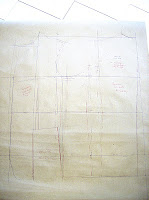After I had my fitting on Friday,I had a couple of hours free, and I thought that would give me an opportunity to try out the Rundshau Draft that I downloaded from The Cutter and Tailor. It is a "modern" drafting system -mid 20th century I guess - and I always like to see whether drafts work as written, and whether I can make any use of them.
I decided to just use a stand to measure and draft for, so I got our my measuring tape, measured the stand and I started.


Well, the first thing is that I don't speak or read German, and neither Susy or Silvia were around to help me translate. I just had the draft and a rough translation that someone posted. I'm not the most patient or dedicated follower of instructions, but I was determined to make the effort, but to quote my husband, "Those Germans have a different word for everything". Long, long words, and although I had to keep referring back and forth to various pages, I did construct a basic suit jacket pattern.
There were a few things I felt were a bit off.
The measurements I was working with were chest 100 cm, waist 86 cm and hip 100 cm.
Following the written instructions didn't produce the same visual pattern as the one they had. So when things didn't look right, I just made decisions that looked better to me than the ones that the draft provided.
I was stymied so I started by looking at the measurements for the sample draft. Chest 96, waist 88, hip 104.
There was 8cm difference between chest to waist which is very little.
The waist to hip difference was 16 cm, which is more usual, but the hips were 8cm bigger than the chest, which I thought was not usual. There was no mention of whether the measurements were standard sizing or not- not that I could have determined that, since, as I said, I don't read German.
So, I'll try cutting it out in muslin and pinning it on the stand to see what it looks like.










